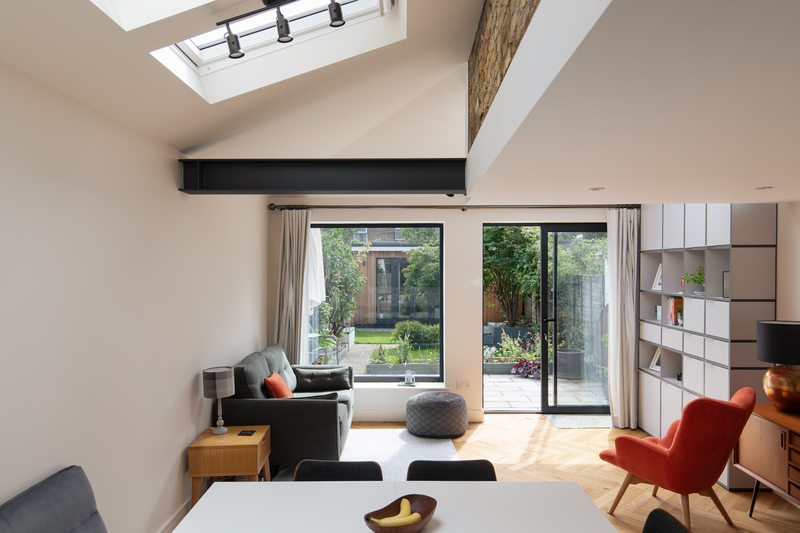Small Side Infill Pitched Roof Extension
The Small Side Infill Pitched Roof Extension: A London Homeowner’s Guide

If you’re a London homeowner seeking additional space without compromising your garden area, a small side infill pitched roof extension could be the perfect solution for you. Having spent years assisting clients in transforming their homes through extensions, I can personally attest to the significant impact this type of project can have.
A small side infill pitched roof extension is a subtle yet powerful way to unlock additional square footage, enhance natural light, and rejuvenate your home without significantly changing its footprint. Let’s explore everything you need to know, including design tips, average costs, and the London neighborhoods where these extensions are highly popular.
What is a Small Side Infill Pitched Roof Extension?


In simple terms, a side infill extension utilizes the narrow, often underutilized alley space that runs alongside many London homes, particularly Victorian and Edwardian terraces. By covering this space and pitching the roof to complement the existing structure, you create a sleek addition that can house anything from a bigger kitchen to a cozy new dining nook.
Unlike flat roof extensions, which can sometimes clash with period homes, a pitched roof extension blends seamlessly with the existing architecture. This is why they’re so popular in conservation areas or among homeowners who want to preserve the classic aesthetic of their property.
Why Go for a Side Infill Pitched Roof Extension?
1. Maximizing Space Without Losing Garden
If your outdoor area is precious to you (and let’s face it, in London, every square foot counts), side infill extensions allow you to expand inward rather than outward. This is especially valuable if you’re eyeing that side alley and wondering what to do with it.
2. Aesthetic Continuity
I often find homeowners worry that extensions will look tacked on. A pitched roof, designed thoughtfully, maintains the charm and flow of the original house, adding to the overall curb appeal. This is a massive win for Victorian and Edwardian homes with their timeless appeal.
3. Light, Light, Light
One of the best parts of a side infill is the opportunity to incorporate rooflights or glass panels, flooding what may have been a dark and dingy kitchen or hallway with natural light. Trust us, once you see the difference, you’ll wonder why you didn’t do it sooner.
The Design Process: Key Considerations
Architectural Integration
A big part of what makes these extensions successful is thoughtful design. It’s not just about throwing up walls; it’s about ensuring the new addition complements the existing space. If you’re working with an architect (which I highly recommend), discuss how the pitch can match your current roof or how the new space can feel like a natural extension of your home.
Skylights and Glazing
Consider incorporating skylights or a row of glazed panels along the pitch. This not only makes the space feel brighter but can also add a touch of modern flair. One project Buildify worked on in Hackney had three skylights running parallel to the extension; the result was a bright, open-plan kitchen that became the heart of the home.
Materials
Stick to materials that reflect the style of your existing house. Brick facades and clay tiles often work best for period properties, while timber or metal accents can modernize the look without jarring against the traditional elements.
How Much Does a Small Side Infill Pitched Roof Extension Cost in London?
Alright, let’s talk numbers. London isn’t exactly the cheapest place to build, but knowing the ballpark figures can help you budget realistically.
Average Costs (2025 Estimates):
- Per Square Metre: £3,900 – £6,500
- Single-Storey Extension: £30,000 – £45,000
- Double-Storey Extension: £45,000 – £65,000
Additional Costs to Consider:
- Architectural Fees: 5-15% of construction costs
- Planning Application: Roughly £206 in England
- VAT and Contingencies: Always add 10-15% extra for surprises (because they happen!)
For context, a friend of mine recently completed a small side infill extension in Islington for about £40,000. The project took around four months, and by the end of it, they had a stunning open-plan kitchen with bi-fold doors leading to the garden. The increase in property value? Easily double what they spent.
Popular London Areas for Side Infill Pitched Roof Extensions
While side infill extensions can work almost anywhere, certain areas see more of these projects due to the type of housing stock.
North London:
- Islington & Camden: Rows of Victorian terraces mean homeowners are always looking to maximize side returns.
South London:
- Clapham & Balham: Edwardian semi-detached houses often have narrow side alleys that are prime for infill extensions.
West London:
- Chiswick & Hammersmith: Families in this area love the idea of expanding kitchen and dining areas while keeping their garden space intact.
East London:
- Hackney & Bethnal Green: Side infill extensions are a staple of East London home renovations, often with a sleek, modern twist.
What Types of Homes Suit Side Infill Extensions?
This style of extension works best for:
- Victorian Terraces
- Edwardian Properties
- Semi-Detached Houses
In other words, if you’ve got a narrow side return, you’re in luck.
Do You Need Planning Permission?
The short answer is—it depends. Many side infill extensions fall under permitted development rights, but this isn’t a blanket rule, especially in conservation areas or listed buildings. It’s always worth checking with your local planning authority. And yes, while planning permission might feel like a hassle, it’s far better than tearing down unauthorized work (trust me, I’ve seen it happen).
FAQ (Frequently asked questions)
Q1: How long does a small side infill extension take to complete?
A: On average, most projects take between 3 to 6 months, depending on complexity and weather conditions.
Q2: Can I live in my home during the construction?
A: Yes, though it might get noisy and dusty. Some homeowners choose to stay elsewhere during heavy construction phases.
Q3: Is it worth the investment?
A: Absolutely. Many homeowners see a return of 15-25% on their investment through increased property value.
Q4: Will a pitched roof cost more than a flat roof extension?
A: Typically, yes. A pitched roof is more complex to construct, but it often adds more character and longevity to the extension.
Q5: Can I add a side infill extension to a listed building?
A: It’s possible, but planning permissions are stricter. Consult with your local planning authority early on.
Final Thoughts
A small side infill pitched roof extension can revolutionize the way you use your home. Whether you’re adding a bigger kitchen, a new dining area, or just need more breathing space, this type of project ticks all the boxes. The best part? You can add value to your home while staying true to its original character.
So, if you’ve been eyeing that awkward side alley, now’s the time to turn it into something truly special.









